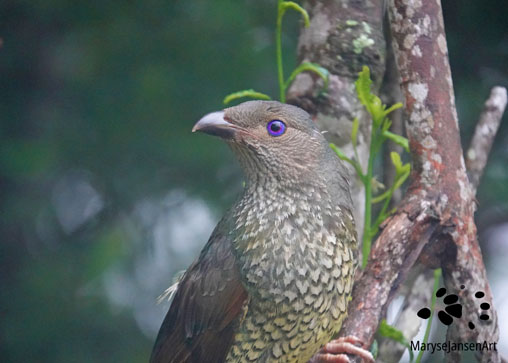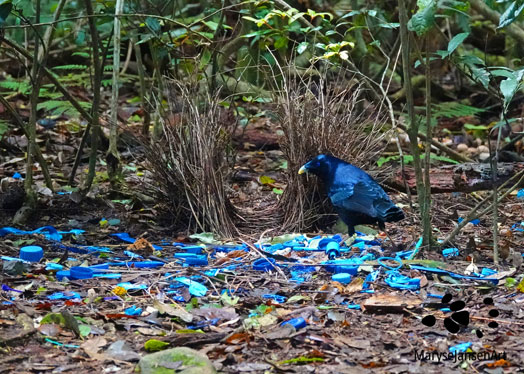Bird Photography with marysejansenart
Treasures of the rainforest

A stunning purple-blue eye
Suddenly I feel like I’m being watched. I look up into the most stunning eye I have ever seen! The amazing purple-blue colour draws me right in. There has to be a story there!
I am wandering around in an ancient rainforest, there is so much to see that I need eyes everywhere! Such a variety of plant-life and bird-life as well as an assortment of marsupials, spiders, reptiles and insects. While the dominating colour in the forest is all shades of green, it gets brightened up by small patches of intense colour: little fluorescent orange fungi, the majestic red head and chest of the male King Parrot, the bright yellow breast of the Golden Whistler…. But nothing can beat that purple-blue eye!
The eye belongs to the female Satin Bowerbird. This bird is something special! While the male Satin Bowerbird is a glossy blue-black bird, the female could be called dull in her olive, brown and cream plumage if it wasn’t for her gorgeous purple-blue eye. The male bird agrees, he is captivated by her eye. And he goes to great length to please it.
Building bowers to please the eye
Bowerbirds have developed a very special technique to get the attention from the ladies: they build bowers. The bower consists of an avenue of two parallel rows of sticks and it is the focal point of the male’s territory where courting and mating rituals take place. The male bird makes a big effort to decorate his bower with pretty things such as flowers, berries, feathers and cicada shells.
He is quite picky about the colour scheme. Yellow and brown objects make it in, but above all he has a very strong preference for blue! As if he’s looking to match the colour of her eye! He will go out of his way to get as many blue objects in his bower as he can. He does not shy away from ‘stealing’ artificial objects from the human world such as plastic straws, pegs, bottle tops and pieces of glass. The end result is quite spectacular!

To my great excitement I find a bower during my next walk! Unfortunately it’s quite busy on the track and the male bird is nowhere to be seen. Something tells me to wait. I make myself comfortable on the log of a fallen tree and look around. A Yellow Robin shows it’s colours a couple of times, but no sign of the Bowerbird.
I wait a little longer…. There he is! At a distance, in the trees, but that’s definitely him! His glossy blue-black feathers shine in the dappled sunlight and he has an equally beautiful eye to the female! Tentatively he comes closer to the bower and checks that the crowd has gone before he feels safe to enter his palace again. I don’t move a muscle, camera at the ready! Then he descends from the trees and begins reorganizing his theatre. Woohoo! This made my day!
Showtime
Spectacular as it may look, the bower is never finished, the bird is known to constantly rearrange his treasures and maintain his stick wall avenue! When a female shows interest, he will proceed to do his mating dance: a range of prancing, strutting and bowing movements, occasionally quivering his outstretched wings. The moves are accompanied by sounds like hissing, rattling and buzzing. He will show off one of his blue treasures by carrying it in his beak during the display.
It can take a while for him to convince the female bird of his outstanding skills. She will visit the site multiple times if she’s interested. If he finally manages to impress her, she will enter the bower avenue and allow him to mate with her. When the deed is done, she leaves him to go and deal with her nesting duties. The male bird simply continues to look after his bower and tries to attract more females to create offspring with.
The female bird builds a shallow cup-shaped nest in a bush or a tree and it takes about 3 weeks for her eggs to hatch. Another 3 weeks later the young bowerbirds begin to leave the nest.
It takes them 7 years however to become reproductively mature! There is a lot to learn! Young males have a similar greenish colour as the females have and only by the age of 7 years old they will develop their shiny blue-black plumage. Immature males can already be seen practicing their bower building skills. Bowerbirds can live for 20-30 years!
Looking into the life of birds can reveal amazing secrets! With that knowledge the sightings get even more exciting! Happy bird watching!
For more stories about Australia’s amazing birds, click here.
If you are interested in purchasing ‘It’s all in the Eye’ or would like to see what it looks like on the various products, please head to my shop.


